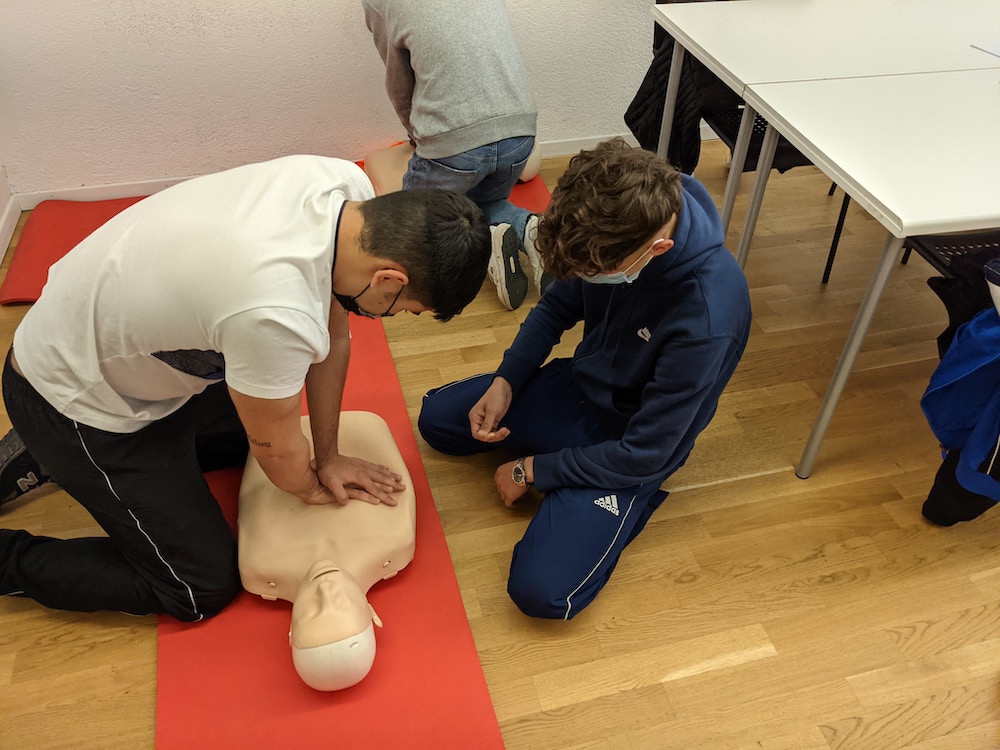Find Your First Aid Training Company
First aid training for workplaces in Southern Ontario, Canada typically involves teaching employees the basic skills and knowledge required to respond effectively to medical emergencies until professional help arrives.
The training usually covers a range of topics, such as CPR, wound care, and recognizing and responding to different types of medical emergencies. Although the specific content may vary depending on the workplace, most workplace first aid training programs include the following elements:
- Introduction to first aid: This provides an overview of the importance of first aid, the legal responsibilities of a first aider, and the role of first aid in the workplace.
- Basic life support (CPR): Participants learn how to perform cardiopulmonary resuscitation (CPR) on adults, children, and infants, including the use of automated external defibrillators (AEDs) when available.
- Choking: Trainees are taught how to recognize and respond to choking incidents, including the Heimlich maneuver and other techniques for clearing airway obstructions.
- Wound care: Participants learn how to manage various types of wounds, such as cuts, abrasions, punctures, and burns, including proper cleaning, dressing, and bandaging techniques.
- Managing medical emergencies: Training typically covers recognition and response to common medical emergencies, such as heart attacks, strokes, seizures, asthma attacks, and allergic reactions.
- Fractures and dislocations: Trainees learn how to recognize and manage different types of fractures and dislocations, as well as the proper use of immobilization techniques like splints and slings.
- Head, neck, and spinal injuries: Participants are taught how to assess and manage potential head, neck, and spinal injuries, including the use of spinal immobilization techniques when necessary.
- Poisoning and toxic exposure: Trainees learn how to recognize the signs of poisoning and toxic exposure, as well as how to respond appropriately based on the type of substance involved.
- Heat and cold emergencies: Participants are taught how to recognize and manage heat-related illnesses (e.g., heat exhaustion, heatstroke) and cold-related illnesses (e.g., hypothermia, frostbite).
- Practical exercises: Hands-on practice is usually incorporated throughout the training, allowing participants to apply their newly acquired skills in simulated emergency situations.

Emergency first aid training for workplaces in cities like Oakville, Burlington, Guelph, and Brantford cover a lot of ground and depending on if your company is taking the training for the first time, or if you are re-certifying employees, the length of the course is different:
The duration of first aid training for workplaces may vary, ranging from a few hours to a couple of days, depending on the depth and scope of the program. First aid training providers often offer certifications upon successful completion of the course, which may need to be renewed periodically.
What Are the Benefits of Emergency First Aid Training?
There are several benefits to both employees and employers when they partake in first aid training. These benefits include:
Benefits For Employees:
- Improved safety awareness: First aid training helps employees become more aware of potential hazards and risks in the workplace, leading to a safer environment.
- Confidence and competence: Employees who receive first aid training are better prepared to handle medical emergencies, which can boost their confidence and competence in dealing with such situations.
- Faster response times: Trained employees are more likely to recognize emergencies and respond quickly, helping to minimize the severity of injuries or medical conditions.
- Team building and communication: Participating in first aid training together can strengthen teamwork, improve communication, and foster a sense of responsibility among employees.
- Personal development: First aid training equips employees with valuable life-saving skills that can be applied both in the workplace and in their personal lives.
Benefits For Employers:
- Compliance with regulations: Many countries have laws and regulations requiring employers to provide first aid training for employees. Ensuring that your workforce is adequately trained can help your business stay compliant with these requirements.
- Reduced workplace injuries: A well-trained workforce can identify and address potential hazards, leading to fewer workplace accidents and injuries.
- Lower costs: Fewer injuries and accidents can result in reduced workers’ compensation claims and lower insurance premiums for employers.
- Enhanced company reputation: A commitment to employee safety and well-being can improve a company’s reputation, helping to attract and retain top talent, as well as enhancing the company’s image in the eyes of customers and partners.
- Increased productivity: A safer work environment can lead to increased employee morale, reduced absenteeism, and higher overall productivity.

What are the Key Takeaways for Why a Company Should Invest in First Aid Training?
Overall, first aid training for employees and employers promotes a safer, healthier, and more productive workplace, benefiting both individuals and the organization as a whole.
- Enhanced workplace safety: First aid training equips employees with the skills and knowledge necessary to identify potential hazards and respond effectively to medical emergencies, leading to a safer work environment and reduced risk of injuries.
- Improved emergency response: Trained employees can recognize emergencies more quickly and provide appropriate first aid care until professional help arrives, potentially saving lives and minimizing the severity of injuries or medical conditions.
- Compliance and reputation: Ensuring that employees receive adequate first aid training helps businesses comply with relevant laws and regulations, while demonstrating a commitment to employee safety and well-being, which can enhance the company’s reputation and foster a positive work culture.
-
In the modern era of ‘everything online’, is there no longer a need for in class emergency first aid training, or can it all be done virtually?
Online Versus In Person First Aid Training Courses
The choice between live first aid safety training and an online first aid training course depends on various factors, including the specific needs of your workplace, available resources, and the desired level of training. Both options have their advantages and limitations.
Live first aid safety training:
Pros:
- Hands-on practice: Live training typically includes practical exercises, allowing participants to practice their newly acquired skills in a controlled, supervised environment.
- Real-time feedback: Instructors can provide immediate feedback and guidance to help participants improve their first aid techniques.
- Customization: Live training can be tailored to address specific workplace hazards or scenarios, making it more relevant to the participants.
- Interactive learning: Participants can ask questions, share experiences, and engage in group discussions, which can enhance learning and retention.
Cons:
- Scheduling challenges: Coordinating live training sessions for all employees can be difficult, especially for larger organizations or those with multiple locations.
- Cost: Live training can be more expensive than online courses, as it may involve travel, venue, and instructor fees.
Online first aid safety training:
Pros:
- Flexibility: Online courses can be completed at the participant’s own pace and schedule, making it more convenient for those with busy schedules or remote work arrangements.
- Consistency: Online training ensures that all participants receive the same information and instruction, promoting consistency across the organization.
- Cost-effective: Online courses are often more affordable than live training, as there are no travel, venue, or instructor fees involved.
Cons:
- Limited hands-on practice: Online training may not provide the same level of hands-on practice as live training, which could affect skill development and retention.
- Lack of real-time feedback: Participants may not receive immediate feedback or guidance from an instructor, potentially leading to the development of incorrect techniques or misunderstandings.
Ultimately, the best choice will depend on your organization’s specific needs and goals. A blended approach, combining online training with occasional live sessions or skill assessments, may provide an optimal balance between flexibility, cost-effectiveness, and hands-on practice.

A Certified Emergency First Aid Training Company
- Alternative Safety Solutions
- 22 Augusta Street, Scotland, ON N0E 1R0
- Serving Southern Ontario
- 1-519-717-4601
- https://alternativesafetysolutions.ca/courses/emergency-first-aid/



